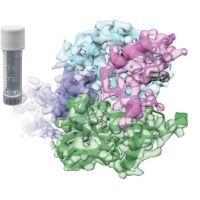Specification
| Description | Recombinant protein from the full-length sequence of homo sapiens interferon, gamma-inducible protein 16 (IFI16), transcript variant 2 (NM_005531). |
| Organism | Homo sapiens (Human) |
| Expression Host | Human Cells |
| Tag Info | His or DYKDDDDK. Please contact us if you need further information or require specific designed tag. |
| Purity | Greater than 90% by SDS-PAGE gel |
| Uniprot ID | Q16666 |
| Entry Name | IF16_HUMAN |
| Gene Names | IFI16 IFNGIP1 |
| Alternative Gene Names | IFNGIP1 |
| Alternative Protein Names | Gamma-interferon-inducible protein 16 (Ifi-16) (Interferon-inducible myeloid differentiation transcriptional activator) |
| Application | Antigens, Western, ELISA and other in vitro binding or in vivo functional assays, and protein-protein interaction studies; For research & development use only! |
| Buffer | Purified protein formulated in a sterile solution of PBS buffer, pH7.2, without any preservatives |
| Endotoxin | Endotoxin level is < 0.1 ng/µg of protein (<1EU /µg) |
| Length | 785 |
| Molecular Weight(Da) | 88256 |
| Protein Sequence | (The sequence of expressed protein may have some variation from the sequence shown below. Please contact us for the exact sequence.) MGKKYKNIVLLKGLEVINDYHFRMVKSLLSNDLKLNLKMREEYDKIQIADLMEEKFRGDAGLGKLIKIFEDIPTLEDLAETLKKEKLKVKGPALSRKRKKEVDATSPAPSTSSTVKTEGAEATPGAQKRKKSTKEKAGPKGSKVSEEQTQPPSPAGAGMSTAMGRSPSPKTSLSAPPNSSSTENPKTVAKCQVTPRRNVLQKRPVIVKVLSTTKPFEYETPEMEKKIMFHATVATQTQFFHVKVLNTSLKEKFNGKKIIIISDYLEYDSLLEVNEESTVSEAGPNQTFEVPNKIINRAKETLKIDILHKQASGNIVYGVFMLHKKTVNQKTTIYEIQDDRGKMDVVGTGQCHNIPCEEGDKLQLFCFRLRKKNQMSKLISEMHSFIQIKKKTNPRNNDPKSMKLPQEQRQLPYPSEASTTFPESHLRTPQMPPTTPSSSFFTKKSEDTISKMNDFMRMQILKEGSHFPGPFMTSIGPAESHPHTPQMPPSTPSSSFLTTKSEDTISKMNDFMRMQILKEGSHFPGPFMTSIGPAESHPHTPQMPPSTPSSSFLTTLKPRLKTEPEEVSIEDSAQSDLKEVMVLNATESFVYEPKEQKKMFHATVATENEVFRVKVFNIDLKEKFTPKKIIAIANYVCRNGFLEVYPFTLVADVNADRNMEIPKGLIRSASVTPKINQLCSQTKGSFVNGVFEVHKKNVRGEFTYYEIQDNTGKMEVVVHGRLTTINCEEGDKLKLTCFELAPKSGNTGELRSVIHSHIKVIKTRKNKKDILNPDSSMETSPDFFF |
Background
| Function | FUNCTION: Binds double-stranded DNA. Binds preferentially to supercoiled DNA and cruciform DNA structures. Seems to be involved in transcriptional regulation. May function as a transcriptional repressor. Could have a role in the regulation of hematopoietic differentiation through activation of unknown target genes. Controls cellular proliferation by modulating the functions of cell cycle regulatory factors including p53/TP53 and the retinoblastoma protein. May be involved in TP53-mediated transcriptional activation by enhancing TP53 sequence-specific DNA binding and modulating TP53 phosphorylation status. Seems to be involved in energy-level-dependent activation of the ATM/ AMPK/TP53 pathway coupled to regulation of autophagy. May be involved in regulation of TP53-mediated cell death also involving BRCA1. May be involved in the senescence of prostate epithelial cells. Involved in innate immune response by recognizing viral dsDNA in the cytosol and probably in the nucleus. After binding to viral DNA in the cytoplasm recruits TMEM173/STING and mediates the induction of IFN-beta. Has anti-inflammatory activity and inhibits the activation of the AIM2 inflammasome, probably via association with AIM2. Proposed to bind viral DNA in the nucleus, such as of Kaposi's sarcoma-associated herpesvirus, and to induce the formation of nuclear caspase-1-activating inflammasome formation via association with PYCARD. Inhibits replication of herpesviruses such as human cytomegalovirus (HCMV) probably by interfering with promoter recruitment of members of the Sp1 family of transcription factors. Necessary to activate the IRF3 signaling cascade during human herpes simplex virus 1 (HHV-1) infection and promotes the assembly of heterochromatin on herpesviral DNA and inhibition of viral immediate-early gene expression and replication. Involved in the MTA1-mediated epigenetic regulation of ESR1 expression in breast cancer. {ECO:0000269|PubMed:11146555, ECO:0000269|PubMed:12894224, ECO:0000269|PubMed:14654789, ECO:0000269|PubMed:20890285, ECO:0000269|PubMed:21573174, ECO:0000269|PubMed:21575908, ECO:0000269|PubMed:22046441, ECO:0000269|PubMed:22291595, ECO:0000269|PubMed:23027953, ECO:0000269|PubMed:24198334, ECO:0000269|PubMed:24413532, ECO:0000269|PubMed:9642285}. |
| Pathway | |
| Protein Families | HIN-200 family |
| Tissue Specificity | Expressed in peripheral blood leukocytes, fibroblasts and lymphoid cells. Present in myeloid precursors (CD34+) and throughout monocyte development, but its expression is down-regulated in erythroid and polymorphonuclear precursor cells. Present in prostate, ovary and breast (at protein level). {ECO:0000269|PubMed:12894224}. |
QC Data
| Note | Please contact us for QC Data |
| Product Image (Reference Only) |  |

